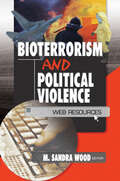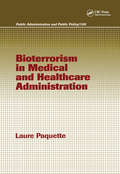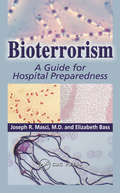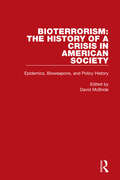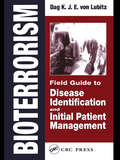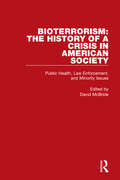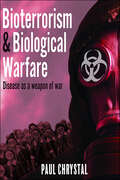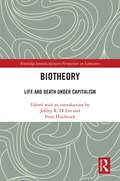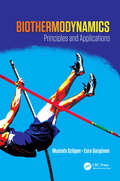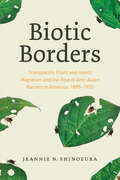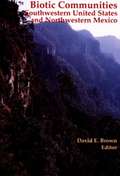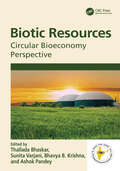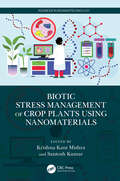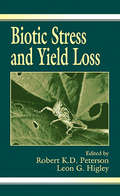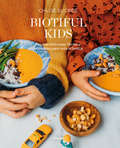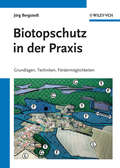- Table View
- List View
Bioterrorism and Political Violence: Web Resources
by M. Sandra WoodThe Internet can be a bewildering maze of information, often from questionable sources. This book points the way to reliable information on bioterror! Since the September 11 attacks, there has been an unparalleled demand for information on bioterrorism. Bioterrorism and Political Violence: Web Resources is an ideal guide for people around the world who are turning to the Internet to find that information. This essential book provides you with comprehensive listings of many helpful websites, focusing on those run by government agencies, professional organizations, and educational institutions. Because of the dynamic nature of the Internet, Bioterrorism and Political Violence: Web Resource also gives you tips on searching for other useful sites. It examines sites covering the full spectrum of concerns, from anthrax and hate crimes to nuclear terrorism and disaster preparedness. Bilingual resources and ways to help children cope with our rapidly changing world are also highlighted throughout. It?s been said that ?information is the best defense,? and with this book you?ll be able to find the information you need. Bioterrorism and Political Violence: Web Resources will also show you how to find reliable information on related topics, including: post-traumatic stress disorder terms and issues related to terrorism in the Middle East sites that honor the victims of the September 11 attacks dealing with bereavement and grief the psychological impacts of terrorism
Bioterrorism in Medical and Healthcare Administration (Public Administration and Public Policy)
by Laure PaquetteBioterrorism in Medical and Healthcare Administration provides an efficient method to identify, manage, and control transformations in the provision of health services during elevated levels of bioterrorist threat - offering step-by-step procedures and templates to prepare and implement a coordinated response to high-alert situations. This reference proposes an efficient method to identify, manage, and control transformations in the provision of health services during elevated levels of bioterrorist threat - offering step-by-step procedures and templates to prepare and implement a coordinated response to high-alert situations.
Bioterrorism: A Guide for Hospital Preparedness
by Elizabeth Bass Joseph R. Masci M.D.In the battle against bioterrorism, one of the greatest challenges is finding the ideal balance between complacency and overreaction. The goal is to be so well prepared that we can prevent catastrophic outcomes in the event of a bioterrorist attack, while strengthening our ability to prevent and treat naturally-occurring infectious diseases.Bioterr
Bioterrorism: Epidemics, Bioweapons, and Policy History (Bioterrorism: The History of a Crisis in American Society)
by David McBrideOriginally published in 2003 and now reissued with a new introduction, this collection provides an invaluable, academic resource on the challenges bioterrorism posed for American society and institutions. Critically selected essays from a wide range of disciplines document and analyze the problems and implications for political, economic, and legal institutions, as well as the challenges a weapon of disease and fear can impose on public health and public policy. By placing bioterrorism into its historical context, this collection also traces the academic research and historical decisions that have contributed to the formation of American policies attempting to cope with a potentially catastrophic attack on the population in general and urban population in particular.
Bioterrorism: Field Guide to Disease Identification and Initial Patient Management
by Dag K.J.E. von LubitzThe outbreak of anthrax infections that followed September 11, 2001, showed all too clearly that while we can defend ourselves against bioterrorism, our defenses need improvement. What's most important is the ability to recognize the associated disease, and recognize them quickly. Yet, many in the medical world are unfamiliar with the characteristi
Bioterrorism: Public Health, Law Enforcement, and Minority Issues (Bioterrorism: The History of a Crisis in American Society)
by David McBrideOriginally published in 2003 and now reissued with a new introduction, this collection provides an invaluable, academic resource on the challenges bioterrorism posed for American society and institutions. Critically selected essays from a wide range of disciplines document and analyze the problems and implications for political, economic, and legal institutions, as well as the challenges a weapon of disease and fear can impose on public health and public policy. By placing bioterrorism into its historical context, this collection also traces the academic research and historical decisions that have contributed to the formation of American policies attempting to cope with a potentially catastrophic attack on the population in general and urban population in particular.
Bioterrorism & Biological Warfare: Disease as a Weapon of War
by Paul ChrystalA timely examination of the use of disease and germs as a weapon of mass destruction (WMD) and the threat bioterrorism poses in an increasingly unpredictable and volatile future. This important, disturbing and timely book focuses on on the use of disease and germs as a weapon of mass destruction (WMD) and the threat bioterrorism poses in an increasingly unpredictable and volatile future for the world. For context it traces developments from the earliest primitive but effective days of infectious rams, poison-tipped arrows and plague-infected corpses used as toxic, disease-spreading projectiles, to the twenty-first-century industrial scale weaponization of biomedicine. Paul Chrystal shows how biological weapons and acts of bioterrorism are especially effective at instilling terror, panic, death, famine and economic ruin on a large scale, shredding public confidence in governments and civilization itself. For the disaffected, lethal biological agents are comparatively easy to manufacture and obtain, and they have the benefit of being almost invisible and easy and quick to administer in lethal quantities through a variety of discreet delivery systems. Just what the terrorist wants. We explore the sinister connection between the industrial-scale proliferation of biological weaponry by state actors and the greater opportunities these growing bio-arsenals give to the increasingly scientific-minded and determined terrorist to manufacture his or her weapon of choice, taking advantage also of the state of the art sophisticated delivery systems. The epilogue analyzes the concerted but groundless 2022-2023 disinformation campaign conducted by Russia, with support from China, relating to the claim that public health facilities in Ukraine are 'secret U.S.-funded biolabs', purportedly developing biological weapons.
Biotheory: Life and Death under Capitalism (Routledge Interdisciplinary Perspectives on Literature)
by Peter Hitchcock Jeffrey R. Di LeoForged at the intersection of intense interest in the pertinence and uses of biopolitics and biopower, this volume analyzes theoretical and practical paradigms for understanding and challenging the socioeconomic determinations of life and death in contemporary capitalism. Its contributors offer a series of trenchant interdisciplinary critiques, each one taking on both the specific dimensions of biopolitics and the deeper genealogies of cultural logic and structure that crucially inform its impress. New ways to think about biopolitics as an explanatory model are offered, and the subject of bios (life, ways of life) itself is taken into innovative theoretical possibilities. On the one hand, biopolitics is addressed in terms of its contributions to forms and divisions of knowledge; on the other, its capacity for reformulation is assessed before the most pressing concerns of contemporary living. It is a must read for anyone concerned with the study of bios in its theoretical profusions.
Biotherapeutics: From small to large molecules and cells (Topics in Medicinal Chemistry #42)
by Victoria Calzada Hugo Cerecetto Juan Pablo TosarThis book reviews biotherapeutics from a medicinal chemistry perspective. It covers proteins, nucleic acids, low molecular weight hormones, small peptides, extracellular vesicles, gene therapy, cell-based products, and tissue-engineered products. Expert contributors provide insights into the mechanisms of action and translational processes of biotherapeutics. Particular attention is given to the latest developments in therapeutic proteins and nucleic acids. Biotherapeutic formulation developments like encapsulation, structural modifications and nanovehiculization are also presented in this book. Divided into 15 chapters, the book begins with basic concepts and definitions of biotherapeutics from a medicinal chemistry standpoint. The following chapters focus on therapeutic proteins, monoclonal antibodies, protein production, and structural modifications. Other chapters cover topics such as antisense oligonucleotides, aptamers, mRNA, gene therapy, as well as other biotherapeutics like low molecular weight hormones and small peptides. The book concludes with an overview of biotherapeutic formulations and an authoritative discussion on regulatory aspects. Throughout the book, readers will learn how biotherapeutics, whether obtained through bioprocesses or not, impact bioresponses and can be utilized for therapeutic purposes. Given its breadth, the book appeals to researchers in medicinal chemistry and biotherapeutics, scholars of medicinal chemistry, students at all levels of biochemical studies, practitioners in the medical field, and anyone interested in biotherapeutics.
Biotherapy - History, Principles and Practice: A Practical Guide to the Diagnosis and Treatment of Disease using Living Organisms
by Martin Grassberger Christopher M.H. Kim Kosta Y. Mumcuoglu Olga S. Gileva Ronald A. ShermanBiotherapy is defined as the use of living organisms in the treatment and diagnosis of human and animal diseases. This volume is an evocative exploration of the history, scientific basis and practical use of the major biotherapy modalities. The authors provide researchers and practitioners interested in this field, with cutting-edge material on the latest key advances in the following fields of biotherapy: Maggot Therapy, Hirudotherapy, Bee Venom Therapy, Apitherapy, Ichthyotherapy, Helminth Therapy, Phage Therapy, Animal Assisted Therapy, Canine Olfactory Detection. In addition, the authors provide with their chapters an extensive bibliography that represents a state-of-the-art survey of the literature. Comprehensive and current, this fresh volume of reviews is an essential resource for professionals who need to stay ahead of the game in the exciting field of biotherapy.
Biothermodynamics: Principles and Applications
by Mustafa Ozilgen Esra Sorguven OnerOver the past several decades there has been increasing research interest in thermodynamics as applied to biological systems. This concerns topics such as muscle work and internal energy such as fat and starch. Applications of the first and second laws of thermodynamics to the human body are important to dieticians and health science experts, and applications of these concepts to the animal body are a major concern of animal scientists. This book covers these key topics, which are typically not covered in classic or traditional thermodynamics texts used in mechanical and chemical engineering.
Biotic Borders: Transpacific Plant and Insect Migration and the Rise of Anti-Asian Racism in America, 1890–1950
by Jeannie N. ShinozukaA rich and eye-opening history of the mutual constitution of race and species in modern America. In the late nineteenth century, increasing traffic of transpacific plants, insects, and peoples raised fears of a "biological yellow peril" when nursery stock and other agricultural products shipped from Japan to meet the growing demand for exotics in the United States. Over the next fifty years, these crossings transformed conceptions of race and migration, played a central role in the establishment of the US empire and its government agencies, and shaped the fields of horticulture, invasion biology, entomology, and plant pathology. In Biotic Borders, Jeannie N. Shinozuka uncovers the emergence of biological nativism that fueled American imperialism and spurred anti-Asian racism that remains with us today. Shinozuka provides an eye-opening look at biotic exchanges that not only altered the lives of Japanese in America but transformed American society more broadly. She shows how the modern fixation on panic about foreign species created a linguistic and conceptual arsenal for anti-immigration movements that flourished in the early twentieth century. Xenophobia inspired concerns about biodiversity, prompting new categories of “native” and “invasive” species that defined groups as bio-invasions to be regulated—or annihilated. By highlighting these connections, Shinozuka shows us that this story cannot be told about humans alone—the plants and animals that crossed with them were central to Japanese American and Asian American history. The rise of economic entomology and plant pathology in concert with public health and anti-immigration movements demonstrate these entangled histories of xenophobia, racism, and species invasions.
Biotic Borders: Transpacific Plant and Insect Migration and the Rise of Anti-Asian Racism in America, 1890–1950
by Jeannie N. ShinozukaA rich and eye-opening history of the mutual constitution of race and species in modern America. In the late nineteenth century, increasing traffic of transpacific plants, insects, and peoples raised fears of a "biological yellow peril" when nursery stock and other agricultural products shipped from Japan to meet the growing demand for exotics in the United States. Over the next fifty years, these crossings transformed conceptions of race and migration, played a central role in the establishment of the US empire and its government agencies, and shaped the fields of horticulture, invasion biology, entomology, and plant pathology. In Biotic Borders, Jeannie N. Shinozuka uncovers the emergence of biological nativism that fueled American imperialism and spurred anti-Asian racism that remains with us today. Shinozuka provides an eye-opening look at biotic exchanges that not only altered the lives of Japanese in America but transformed American society more broadly. She shows how the modern fixation on panic about foreign species created a linguistic and conceptual arsenal for anti-immigration movements that flourished in the early twentieth century. Xenophobia inspired concerns about biodiversity, prompting new categories of “native” and “invasive” species that defined groups as bio-invasions to be regulated—or annihilated. By highlighting these connections, Shinozuka shows us that this story cannot be told about humans alone—the plants and animals that crossed with them were central to Japanese American and Asian American history. The rise of economic entomology and plant pathology in concert with public health and anti-immigration movements demonstrate these entangled histories of xenophobia, racism, and species invasions.
Biotic Borders: Transpacific Plant and Insect Migration and the Rise of Anti-Asian Racism in America, 1890–1950
by Jeannie N. ShinozukaA rich and eye-opening history of the mutual constitution of race and species in modern America. In the late nineteenth century, increasing traffic of transpacific plants, insects, and peoples raised fears of a "biological yellow peril" when nursery stock and other agricultural products shipped from Japan to meet the growing demand for exotics in the United States. Over the next fifty years, these crossings transformed conceptions of race and migration, played a central role in the establishment of the US empire and its government agencies, and shaped the fields of horticulture, invasion biology, entomology, and plant pathology. In Biotic Borders, Jeannie N. Shinozuka uncovers the emergence of biological nativism that fueled American imperialism and spurred anti-Asian racism that remains with us today. Shinozuka provides an eye-opening look at biotic exchanges that not only altered the lives of Japanese in America but transformed American society more broadly. She shows how the modern fixation on panic about foreign species created a linguistic and conceptual arsenal for anti-immigration movements that flourished in the early twentieth century. Xenophobia inspired concerns about biodiversity, prompting new categories of “native” and “invasive” species that defined groups as bio-invasions to be regulated—or annihilated. By highlighting these connections, Shinozuka shows us that this story cannot be told about humans alone—the plants and animals that crossed with them were central to Japanese American and Asian American history. The rise of economic entomology and plant pathology in concert with public health and anti-immigration movements demonstrate these entangled histories of xenophobia, racism, and species invasions.
Biotic Communities: Southwestern United States and Northwestern Mexico
by David BrownellBiotic Communities catalogs and defines by biome, or biotic community, the region centered on Arizona, New Mexico, Sonora, Chihuahua, and Baja California Norte, plus portions of California, Nevada, Utah, Colorado, Texas, Coahuila, Sinaloa, and Baja California Sur. This ambitious guide is an essential companion for anyone working in natural resources management and ecological research, as well as nonspecialists looking for solid information about a particular southwestern locale. Biotic Communities is arranged by climatic formation with a short chapter for each biome describing climate, physiognomy, distribution, dominant and common plant species, and characteristic vertebrates. Subsequent chapters contain careful descriptions of zonal subdivisions.
Biotic Elicitors: Production, Purification, and Characterization (Springer Protocols Handbooks)
by Natarajan Amaresan Dhruti Amin Sanket RayThis volume details techniques to study biotic elicitors involved in the field of agriculture for the benefit of the environment and growers. Chapters guide readers through protein, carbohydrate, lipid, glycoprotein and glycolipid components derived from microorganisms and their production, purification, and characterization. Authoritative and cutting-edge, Biotic Elicitors: Production, Purification, and Characterization serve as an essential resource for researchers in agricultural microbiology, plant biotechnology, and plant pathology. @font-face {font-family:"Cambria Math"; panose-1:2 4 5 3 5 4 6 3 2 4; mso-font-charset:0; mso-generic-font-family:roman; mso-font-pitch:variable; mso-font-signature:-536870145 1107305727 0 0 415 0;}@font-face {font-family:Calibri; panose-1:2 15 5 2 2 2 4 3 2 4; mso-font-charset:0; mso-generic-font-family:swiss; mso-font-pitch:variable; mso-font-signature:-536858881 -1073732485 9 0 511 0;}p.MsoNormal, li.MsoNormal, div.MsoNormal {mso-style-unhide:no; mso-style-qformat:yes; mso-style-parent:""; margin-top:0cm; margin-right:0cm; margin-bottom:8.0pt; margin-left:0cm; line-height:107%; mso-pagination:widow-orphan; font-size:11.0pt; font-family:"Calibri",sans-serif; mso-ascii-font-family:Calibri; mso-ascii-theme-font:minor-latin; mso-fareast-font-family:Calibri; mso-fareast-theme-font:minor-latin; mso-hansi-font-family:Calibri; mso-hansi-theme-font:minor-latin; mso-bidi-font-family:"Times New Roman"; mso-bidi-theme-font:minor-bidi; mso-fareast-language:EN-US;}.MsoChpDefault {mso-style-type:export-only; mso-default-props:yes; font-size:11.0pt; mso-ansi-font-size:11.0pt; mso-bidi-font-size:11.0pt; font-family:"Calibri",sans-serif; mso-ascii-font-family:Calibri; mso-ascii-theme-font:minor-latin; mso-fareast-font-family:Calibri; mso-fareast-theme-font:minor-latin; mso-hansi-font-family:Calibri; mso-hansi-theme-font:minor-latin; mso-bidi-font-family:"Times New Roman"; mso-bidi-theme-font:minor-bidi; mso-fareast-language:EN-US;}.MsoPapDefault {mso-style-type:export-only; margin-bottom:8.0pt; line-height:107%;}div.WordSection1 {page:WordSection1;}
Biotic Resources: Circular Bioeconomy Perspective
by Ashok Pandey Sunita Varjani Thallada Bhaskar Bhavya B. KrishnaThis reference book provides advanced knowledge on sustainable biogenic waste management. It covers innovative waste processing technologies to produce biofuels, energy products, and biochemicals. To create a circular bioeconomy, it is imperative to develop processes where the waste generated through one process acts as a feedstock for the other. This book discusses the latest developments in biochemical and thermochemical methods of conversion and covers the potential of different kinds of biomass in more decentralized biorefineries. It describes sustainable solutions for a greener supplement to fossil resources. The book is meant for microbiologists, chemists, and biotechnologists.
Biotic Stress Management of Crop Plants using Nanomaterials (Advances in Bionanotechnology)
by Santosh Kumar Krishna Kant MishraThis book summarizes nanotechnology-based agricultural research for crop productivity and the management of various plant pathogens. It deals with the application of nano-molecules for quick, cost-effective, and precise plant disease diagnostic procedures, plant pests and disease management, nano-pesticides, and nano-diagnostics. Further, it explains nanomaterials for biotic stress management, with an insight into the synthesis and modification of nanomaterials and their potential applications in different domains for disease management. Features include: Compilation of current research on the Nanomaterials as well as their versatile applications in plant biotic stress management Description of the role of nanomaterials as enzyme-mimicking nanoparticles, nano-pesticides, nano-fertilizers, and nanomaterials Review of day-to-day problems related to crop plants, their diagnostics, and stress management Exploration of trends in nanomaterial utility in diagnostics, enzyme-mimicking, and crop protection, and their possible role in plant disease management Study of pertinent nanomaterials including synthetic strategies, properties, chemistry, and applications This book is aimed at researchers and graduate students in plant pathology, genetic engineering, environmental science, botany, bioengineering, and nanotechnology.
Biotic Stress and Yield Loss
by Robert K.D. Peterson Leon G. HigleyUnderstanding biotic stress and plant yield allows for the practical development of economic decision making, an instrumental part of Integrated Pest Management. And further, the impact of biotic injury on plant yield bears directly on the basic biological questions of population dynamics, life history strategies, community structure, plant-stresso
Biotic Type Antioxidants: the prospective search area for novel chemical drugs
by E A. ParfenovThe discovery of molecular and cellular mechanisms of pathology, together with the present data on drug treatment result in enhanced drug design and testing. The known mechanisms of biological activity as displayed by ascorbic acid and other natural reductones are the reason that they are considered to be physiologically compatible antioxidants, many of which are trace elements in food. The pharmacological potential of natural antioxidants may be enhanced by chemical modification. Biotic antioxidants possess an important potential to be a reliable basis of the development of new multipurpose drugs, within the framework of existing technological structures. This book shows approaches for possible use of these natural antioxidants. In particular, such an approach is described for the case of the design of superoxide dismutase models with anti-tumour activity.
Biotic and Abiotic Stress Tolerance in Plants
by Sharad VatsThis book highlights some of the most important biochemical, physiological and molecular aspects of plant stress, together with the latest updates. It is divided into 14 chapters, written by eminent experts from around the globe and highlighting the effects of plant stress (biotic and abiotic) on the photosynthetic apparatus, metabolites, programmed cell death, germination etc. In turn, the role of beneficial elements, glutathione-S-transferase, phosphite and nitric oxide in the adaptive response of plants under stress and as a stimulator of better plant performance is also discussed. A dedicated chapter addresses research advances in connection with Capsicum, a commercially important plant, and stress tolerance, from classical breeding to the recent use of large-scale transcriptome and genome sequencing technologies. The book also explores the significance of the liliputians of the plant kingdom (Bryophytes) as biomonitors/bioindicators, and general and specialized bioinformatics resources that can benefit anyone working in the field of plant stress biology. Given the information compiled here, the book will offer a valuable guide for students and researchers of plant molecular biology and stress physiology alike.
Biotiful Kids: Recetas deliciosas, sencillas y saludables para toda la familia
by Chloé SucréeIdeas, trucos e inspiración para preparar comidas diarias ¡y que los niños disfruten y repitan! Alimentar bien a nuestros hijos, a veces, no es tarea fácil. Los niños cambian de gustos a menudo: un día les encanta el brócoli y al día siguiente es lo peor que han probado en su vida. Puede llegar a ser agotador. Pero también es muy gratificante ver como comen todo lo que hemos preparado, con ganas y disfrutándolo. Con estas 90 nuevas recetas, Chloé quiere ayudarnos a que los más pe-queños se alimenten de la mejor forma: equilibrada, con sentido común, que se sientan llenos de energía y, sobre todo, sin obsesiones ni agobios por nuestra parte. «Tengo dos hijos con opiniones sobre todo lo que viven y comen, y que pueden llegar a ser muy exigentes. Eso no quiere decir que tenga que sucumbir a todos sus deseos, pero he aprendido a ser más flexible y creativa.» Chloé Sucrée
Biotiful Moments: 90 recetas saludables para disfrutar y compartir
by Chloé SucréeLa intención de Chloé sigue siendo la misma:Ofrecerte 90 recetas para que te cuides y comas bien. Esta vez, además, quiere ayudarte a convertir cualquier momento alrededor de la mesa en algo extraordinario y singular. Para ello ha elegido 10 biotiful moments: 1. Brunchs, vermuts y BBQ con amigos2. Feeling good3. Cena para dos4. Fiestas en familia5. De picnic6. Menú solo7. Viajes en ruta8. Merienda con niños9. Post baby10.Team teenager Porque no es lo mismo preparar una cena romántica, que hacerte un caldo nutritivo cuando necesitas mimos o que llevar algo cómodo y resultón para una barbacoa con amigos. «Yo, siempre que puedo, busco mis biotiful moments. No tienen que ser días especiales de por sí. Más bien procuro hacer de lo ordinario algo extraordinario. Todo es cuestión de perspectiva, buena actitud y de ponerle ganas. Te invito a hacer lo mismo. Te sorprenderá la cantidad de momentos mágicos que pueden aparecer.»
Biotopschutz in der Praxis: Grundlagen -Techniken - Fordermoglichkeiten - Grundlagen - Planung - Handlungsmöglichkeiten
by Jörg BergstedtWer Biotope wirksam schützen will, muss deren Funktion verstehen. Auch wenn der der hohe Wert von natürlichen Lebensräumen für das ökologische Gleichgewicht der Erde lange bekannt ist, hat es die Natur nach wie vor schwer, sich angesichts des immer größeren Flächenverbrauchs durch den Menschen zu behaupten. Doch mit dem richtigen Handwerkszeug können intakte Biotope selbst dort entstehen, wo man sie kaum vermutet: am Rande von intensiv genutzten Ackerflächen, auf Abraumhalden oder mitten in der Großstadt. Dieser Ratgeber enthält das nötige Hintergrundwissen für den Schutz und die Neuanlage von Biotopen. Er zeigt, worauf es wirklich ankommt - von den ökologischen Grundlagen bis hin zu konkreten Schutzmaßnahmen und bestehenden Fördermöglichkeiten. Rund 30 der wichtigsten Lebensräume werden vorgestellt und ihre Bedeutung für das ökologische Landschaftsgefüge erklärt. Zahlreiche Schemata und Beispielbilder veranschaulichen die konkreten Maßnahmen für den praktischen Biotopschutz, ohne die Komplexität der Ökosysteme dabei auszublenden. Alles was man zum Schutz und bei der Neuanlage von Biotopen wissen muss. Ideal für Unterricht, Jugendarbeit und für alle Praktiker im Biotopschutz. Weiteres Material finden Sie unter www.biotopschutz.de.vu
Biotoxins in Food: Threats and Benefits
by Naga Raju Maddela Sesan Abiodun Aransiola Bunmi Comfort KotunBiotoxins are naturally occurring substances present in living organisms as a way of conferring biological defense or protection on such organisms. But their presence in food has been found to be a threat to unsuspecting food consumers. While they are exploited as biocontrol agents and as a biological defense mechanism against pests and predators in the field, biotoxins are implicated in foodborne illness in humans if consumed. Naturally occurring substances present in food include glycoalkaloids found in potatoes and lectins (phytohemagglutinin) in green beans and red kidney beans. Biotoxins in Food: Threats and Benefits discusses the natural poisons present in food, the threats posed, and the possible detection methods. This book assesses the implications of these biotoxins in food by evaluating the threats posed by the consumption of these naturally occurring poisons and the various emerging detection procedures available in the food industry. Several reports from contributing authors focus on the various threats linked to various food products and offer solutions in terms of removal. Early detection of these biotoxins to prevent food illnesses is well documented.Key Features: Discusses the emerging concepts of types, sources, and distribution of biotoxins in food Addresses the prevalence and applications of biotoxins in food products Analyzes the current detection technology of biotoxins in foods
